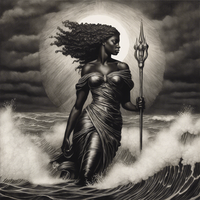Thalassa (planet)
| ||
| Orbital characteristics | ||
| Mass (Kg) | 8.90E+26 | |
| Radius (Km) | 87,770 | |
| Solar Day (h) | 7.83 | |
| Orbital Period (days) | 2,541 | |
| Semi-Major Axis (Km) | 5.01E+08 | |
| Periapsis (AU) | 3.27 | |
| Apoapsis (AU) | 3.5 | |
| Albedo | 0 | |
| Surface Temperature (K) | 110 | |
| Surface Gravity (m/s^2) | 7.71 | |
| Axial Tile (degrees) | 37.6 | |
| Inclination (degrees) | .38 | |
| Orbital Speed (Km/s) | 15 | |
| Satellites | Styx, Faun, Silenus | |
Thalassa is the planet sixth closest to the star Atos, and the second - and largest - of the system's four gas giants. It is also, furthermore, characterized by its distinct golden rings. After Azos and Tarsica, Thalassa is the most prominent body in the Micrasian night sky.
North Polar Regions
Equatorial Regions
Southern Polar Regions
Mythology
Origin
Thalassa, the Lady Divine of the Sea and War, emerged from the depths of the ocean. Born from the tears shed by Atos when the sun was tortured for stealing the light of Azos, she embodies the mysteries of the ocean's depths and the fierceness of its storms.
Epithets
Thalassa is adorned with epithets that reflect her divine nature and influence. Among these titles are "Mistress of the Deep," symbolizing her dominion over the unfathomable depths of the sea, and "Sovereign of Storms," representing her control over the forces of nature. She is also known simply as the "Empress," signifying her exalted status among the pantheon of Reformed Bassarid gods and goddesses.
Worship and Festivals in Bassaridia Vaeringheim
In the coastal cities and port towns of Bassaridia Vaeringheim, especially in the nation's capital city of Vaeringheim, worshipers of Thalassa gather to pay homage to their divine patron during rituals and festivals which take place throughout the course of the year, the most famous of which is the The Rite of the Tidal Communion. This sacred ritual takes place during the changing of the tides, when the ocean's power is at its peak and the connection between Thalassa and her followers is believed to be strongest. During the ritual, members of the Azure Sentinel Sect gather at a secluded coastal shrine dedicated to Thalassa, situated upon a rocky promontory overlooking Lake Morovia. As the lake's waves crash against the rugged cliffs below, initiates prepare themselves for the ritual by donning ceremonial robes adorned with symbols of the ocean and war. The ceremony begins with a solemn procession led by the sect's highest-ranking priestesses, carrying offerings of seashells, pearls, and other treasures to lay at the feet of Thalassa's shrine. Participants then form a circle around the shrine, facing towards the sea, and begin chanting ancient hymns invoking Thalassa's blessings. As the tide begins to rise, reaching its zenith, the participants enter into a meditative trance, induced by extremely high quantities of Noctic-Rabrev, wine, and psychedelic herbs, allowing themselves to become attuned to the rhythmic pulse of the lake's power. They open themselves to Thalassa's presence, seeking guidance, protection, and strength in their sacred duty as guardians of the waters. During the climax of the ritual, participants extend their hands out towards the sea, offering up prayers and invocations to Thalassa. They beseech her to grant them the wisdom to navigate the treacherous waters of life, and the courage to face any challenges that may arise.
Azure Sentinel Sect
At the heart of Thalassa's worship lies the esteemed Azure Sentinel Sect, a sacred order dedicated to the protection of Lake Morovia and the Strait of Haifa, and the preservation of ancient Bassaridian maritime traditions. Comprised of skilled sailors, courageous warriors, and highly devoted mystics, the sect operates as guardians of the coastal realms, defending against threats both natural and supernatural. Members of the sect are known for their mastery of seamanship and maritime magic, harnessing the elemental forces of water and wind to safeguard the ocean's bounty.
Mythology
Ancient myths and legends depict Thalassa as a figure of awe and reverence, her origins steeped in mystery and ancient lore. She is often portrayed as a powerful and enigmatic deity, capable of both nurturing life and unleashing absolute, unparalleled destruction with the fury of the ocean's wrath. Tales of Thalassa's exploits in battle against monstrous sea creatures and rival deities are recounted with reverence and awe, inspiring both fear and admiration among mortals. Thalassa is regarded and revered as the uncontested most powerful of all Planetary Divines.
Iconography and Depictions
In art and iconography, Thalassa is often depicted as a regal figure adorned in flowing robes of azure, her form wreathed in swirling mists and crashing waves. She is frequently portrayed holding a trident, symbolizing her mastery over the seas and her authority as the Lady Divine of War. She is typically depicted with her eyes closed, reflecting the belief that her gaze is capable of driving man and beast alike into the frenzy of war. Symbols associated with Thalassa include the conch, representing the depths of her domain, and the Atteran River Shark, symbolizing her formidable, fierce power and the mysteries of the deep. Depictions of Thalassa capture her majestic presence, inviting worshipers to contemplate the vastness and beauty of the maritime realm.

